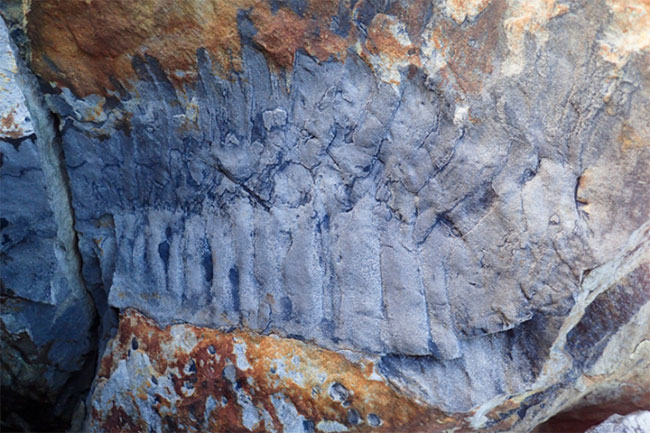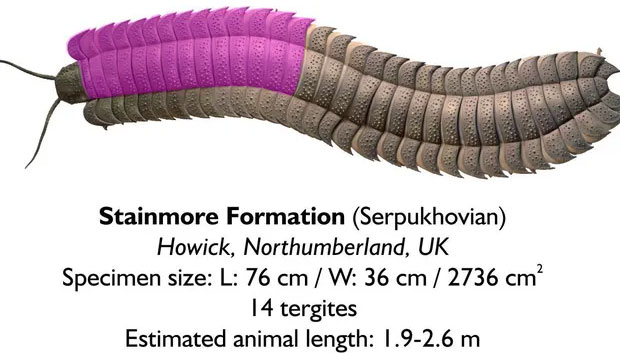Many people fear millipedes because of their appearance, but most millipedes are quite small, with the largest living species being the African giant millipede, which can grow up to 30 cm in length.
If you think a 30 cm long millipede is scary, consider yourself fortunate to be living in modern times rather than in the past, when millipedes could grow as large as a crocodile.
A group of paleontologists announced the discovery of a giant millipede fossil found on a beach in England in 2018. The fossil indicates that it was nearly 3 meters long and may have been a predator.

The fossil indicates that it was nearly 3 meters long and may have been a predator.
Between mid-April 2017 and January 2018, a large sandstone block broke off a cliff in Northumbria, England, and fell about 6 meters onto the beach below. A paleontologist out for a stroll along the beach discovered the rock and realized it contained the fossil of a giant millipede. The research team from the University of Cambridge then analyzed this fossil, and their findings were recently published in the Journal of the Geological Society.
Neil Davies, a paleontologist at the University of Cambridge and the lead author of the study, stated: “It was a completely unexpected discovery. The rock fell and cracked perfectly to expose the fossil that one of our doctors happened to find while passing by.”
This organism was part of the genus Arthropleura and lived about 326 million years ago, 100 million years before the dinosaurs appeared. The fossil is missing its head, but the creature is estimated to have been 55 cm wide, 2.63 m long, and could have weighed 50 kg when alive. This size makes it the largest known invertebrate to date, surpassing the previously held title by giant sea scorpions by at least 10 cm.
Dr. Davies remarked: “It is definitely the largest bug that ever walked on land.” It was so large that it required four people to carry it.

This organism was part of the genus Arthropleura and lived about 326 million years ago.
In fact, this may not even be its largest size, as researchers believe this is not the body of the millipede but merely its exoskeleton, meaning it could have continued to grow larger.
Based on the location of the fossil and the rock, researchers suggest that this fossil was located in a river, where it was covered by sandy sediments for preservation. One reason ancient animals could grow to such enormous sizes is due to the abundant oxygen in the Earth’s atmosphere, but Arthropleura existed before oxygen levels peaked on Earth; thus, other factors may have influenced its size, such as its diet.
Davies suggested that these animals could have been predators, feeding on other invertebrates or even amphibians, or even on their own kind.
The extinction of this giant millipede may be linked to ancient climate change. Davies noted: “These creatures lived near the equator, where it became hot and dry during the Permian period. This may have altered the vegetation and made food scarcer. At the same time, the first reptiles were beginning to dominate terrestrial habitats, so they would have faced much more competition as resources dwindled.”
Researchers estimate that these millipedes had between 32 and 64 legs, significantly fewer than the recently discovered millipede species Eumilipes persephone, which has no eyes and a thread-like body nearly 100 times its width. The record for the most legs is 1,306. Unlike Arthropleura, Eumilipes persephone is still alive, but it is hard to spot as it resides deep underground in a region of Western Australia known as Goldfields, where mineral extraction occurs.


















































